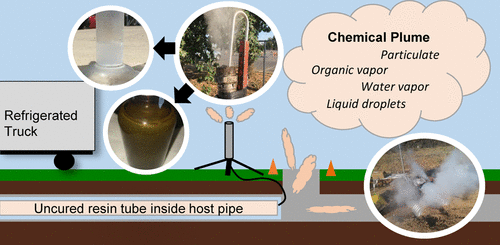当前位置:
X-MOL 学术
›
Environ. Sci. Technol. Lett.
›
论文详情
Our official English website, www.x-mol.net, welcomes your feedback! (Note: you will need to create a separate account there.)
Worksite Chemical Air Emissions and Worker Exposure during Sanitary Sewer and Stormwater Pipe Rehabilitation Using Cured-in-Place-Pipe (CIPP)
Environmental Science & Technology Letters ( IF 10.9 ) Pub Date : 2017-07-26 00:00:00 , DOI: 10.1021/acs.estlett.7b00237 Seyedeh Mahboobeh Teimouri Sendesi 1 , Kyungyeon Ra 2 , Emily N. Conkling 2 , Brandon E. Boor 1 , Md. Nuruddin 3 , John A. Howarter 2, 3 , Jeffrey P. Youngblood 3 , Lisa M. Kobos 4 , Jonathan H. Shannahan 4 , Chad T. Jafvert 1, 2 , Andrew J. Whelton 1, 2
Environmental Science & Technology Letters ( IF 10.9 ) Pub Date : 2017-07-26 00:00:00 , DOI: 10.1021/acs.estlett.7b00237 Seyedeh Mahboobeh Teimouri Sendesi 1 , Kyungyeon Ra 2 , Emily N. Conkling 2 , Brandon E. Boor 1 , Md. Nuruddin 3 , John A. Howarter 2, 3 , Jeffrey P. Youngblood 3 , Lisa M. Kobos 4 , Jonathan H. Shannahan 4 , Chad T. Jafvert 1, 2 , Andrew J. Whelton 1, 2
Affiliation

|
Chemical emissions were characterized for steam-cured cured-in-place-pipe (CIPP) installations in Indiana (sanitary sewer) and California (stormwater). One pipe in California involved a low-volatile organic compound (VOC) non-styrene resin, while all other CIPP sites used styrene resins. In Indiana, the uncured resin contained styrene, benzaldehyde, butylated hydroxytoluene (BHT), and unidentified compounds. Materials emitted from the CIPP worksites were condensed and characterized. An emitted chemical plume in Indiana was a complex multiphase mixture of organic vapor, water vapor, particulate (condensable vapor and partially cured resin), and liquid droplets (water and organics). The condensed material contained styrene, acetone, and unidentified compounds. In California, both styrene and low-VOC resin condensates contained styrene, benzaldehyde, benzoic acid, BHT, dibutyl phthalate, and 1-tetradecanol. Phenol was detected only in the styrene resin condensate. Acetophenone, 4-tert-butylcyclohexanol, 4-tert-butylcyclohexanone, and tripropylene glycol diacrylate were detected only in the low-VOC condensate. Styrene in the low-VOC condensate was likely due to contamination of contractor equipment. Some, but not all, condensate compounds were detected in uncured resins. Two of four California styrene resin condensates were cytotoxic to mouse alveolar type II epithelial cells and macrophages. Real-time photoionization detector monitoring showed emissions varied significantly and were a function of location, wind direction, and worksite activity.
中文翻译:

使用现场固化管道(CIPP)进行下水道和雨水管道修复期间的工作场所化学空气排放和工人暴露
在印第安纳州(下水道)和加利福尼亚州(雨水)中使用蒸汽固化的就地管道固化(CIPP)装置对化学物质排放进行了表征。加利福尼亚的一根管道涉及一种低挥发性有机化合物(VOC)非苯乙烯树脂,而所有其他CIPP场所均使用苯乙烯树脂。在印第安纳州,未固化的树脂包含苯乙烯,苯甲醛,丁基化羟基甲苯(BHT)和不确定的化合物。从CIPP工地排放的材料经过冷凝和表征。印第安纳州排放的化学羽流是有机蒸气,水蒸气,颗粒(可冷凝蒸气和部分固化的树脂)和液滴(水和有机物)的复杂多相混合物。冷凝物包含苯乙烯,丙酮和未知化合物。在加利福尼亚州,苯乙烯和低VOC树脂缩合物均含有苯乙烯,苯甲醛,苯甲酸,BHT,邻苯二甲酸二丁酯和1-十四烷醇。仅在苯乙烯树脂冷凝物中检测到苯酚。苯乙酮4-叔-butylcyclohexanol,4-叔-butylcyclohexanone,和三丙二醇二丙烯酸酯仅在低VOC冷凝进行检测。低VOC冷凝物中的苯乙烯很可能是由于承包商设备的污染所致。在未固化的树脂中检测到一些(但不是全部)冷凝物。四种加利福尼亚苯乙烯树脂缩合物中的两种对小鼠II型肺泡上皮细胞和巨噬细胞具有细胞毒性。实时光电离检测器监测显示,排放量变化很大,并且是位置,风向和工作场所活动的函数。
更新日期:2017-07-28
中文翻译:

使用现场固化管道(CIPP)进行下水道和雨水管道修复期间的工作场所化学空气排放和工人暴露
在印第安纳州(下水道)和加利福尼亚州(雨水)中使用蒸汽固化的就地管道固化(CIPP)装置对化学物质排放进行了表征。加利福尼亚的一根管道涉及一种低挥发性有机化合物(VOC)非苯乙烯树脂,而所有其他CIPP场所均使用苯乙烯树脂。在印第安纳州,未固化的树脂包含苯乙烯,苯甲醛,丁基化羟基甲苯(BHT)和不确定的化合物。从CIPP工地排放的材料经过冷凝和表征。印第安纳州排放的化学羽流是有机蒸气,水蒸气,颗粒(可冷凝蒸气和部分固化的树脂)和液滴(水和有机物)的复杂多相混合物。冷凝物包含苯乙烯,丙酮和未知化合物。在加利福尼亚州,苯乙烯和低VOC树脂缩合物均含有苯乙烯,苯甲醛,苯甲酸,BHT,邻苯二甲酸二丁酯和1-十四烷醇。仅在苯乙烯树脂冷凝物中检测到苯酚。苯乙酮4-叔-butylcyclohexanol,4-叔-butylcyclohexanone,和三丙二醇二丙烯酸酯仅在低VOC冷凝进行检测。低VOC冷凝物中的苯乙烯很可能是由于承包商设备的污染所致。在未固化的树脂中检测到一些(但不是全部)冷凝物。四种加利福尼亚苯乙烯树脂缩合物中的两种对小鼠II型肺泡上皮细胞和巨噬细胞具有细胞毒性。实时光电离检测器监测显示,排放量变化很大,并且是位置,风向和工作场所活动的函数。


























 京公网安备 11010802027423号
京公网安备 11010802027423号